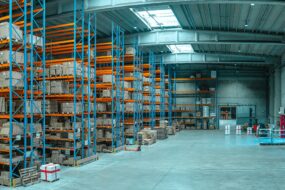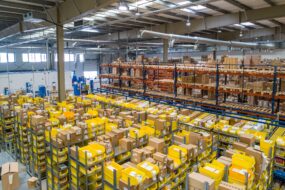Contents
Inventory is one of your biggest assets. It needs to be managed properly to help you optimize your business.
You need to be able to meet customer demands and expectations without spending too much on inventory storage for product that is not moving. An inventory tracking system can help to optimize your inventory management solution.
Using inventory tracking software can increase your profit margins, improve customer satisfaction, and simplify your business logistics. It is important to know what products you have and where they are. This is accomplished through an inventory tracking system.
What Is Inventory Tracking?
An important aspect of your business is to be able to track your inventory in real time. Inventory tracking involves knowing what SKUs you have on hand, where they are being stored, where they are in the retail supply chain (shipping from the supplier, in your warehouse, or being shipped to the customer), and what quantities are available at each of your locations.
As your business grows and evolves, you will often need to advance your inventory tracking system. Inventory can be tracked through a variety of ways, including manual and automated processes.
Inventory Tracking Systems
Inventory tracking systems allow you to track and monitor your inventory levels and quantities of each specific SKU in real time. This is typically performed using an inventory management dashboard, software, or program.
Using inventory management software or an inventory management system is an efficient method for tracking your inventory. It allows you to know how much product you have where, and it provides a high level of accuracy and visibility.
Who Needs Inventory Tracking?
Any business that sells physical goods will need some method of tracking inventory. The bigger the business and more product involved, the more advanced and streamlined inventory tracking should be. Large companies will use complex, automated inventory management and tracking systems, while smaller companies may opt to do these processes manually.
As your company expands and sells more product, a more technological approach to inventory tracking is optimal. Inventory tracking systems can help your business to better manage inventory turnover and make more informed business decisions regarding your products.
Tracking Inventory Throughout the Retail Supply Chain
It is important to be able to track your inventory throughout the entire retail supply chain. This is much more than just counting your products and logging when they move. You will need to track and monitor your inventory as it comes from the supplier, turns over and moves through your fulfillment center and out to customers, as well as when inventory is damaged or returned.
Tracking Inventory From the Supplier
Buying product from the supplier is a massive investment. As such, it is important to protect this investment — to know where it is at all times. You need to track your inventory after you have purchased it, while it is still at your supplier, and while it is in transit to your fulfillment or distribution center.
By knowing exactly where your inventory is, especially when it is not yet directly in your possession, you can help to maximize your sales and meet your customer demands. Failure to know the difference between inventory on hand and inventory that is still in your supplier’s hands can lead to missed sales, late deliveries, and difficulties with your inventory accounting.
Tracking Inventory Turnover
Inventory turnover is when your inventory is sold and replaced. A high and healthy inventory turnover indicates that your products are selling and moving well. On the other hand, if you have a low inventory turnover, this can indicate that your products are not selling as anticipated, and this can cut into your bottom line.
By understanding the average turnover rate for each of your products, you can better optimize your inventory management. This can allow you to ensure that you replenish inventory as needed, set optimal reorder points, and make informed decisions about necessary inventory changes to boost profit margins
Tracking Inventory Returns
Inventory returns are an unfortunate and common aspect of e-commerce, and it is important to know when inventory is sent back to you. By keeping track of what products are being returned and why, you can make informed decisions on whether to keep stocking these products and if they are put back into rotation or need to be examined further.
Tracking Damaged Goods
It is also important to account for damaged goods in your inventory, as these goods are not able to be resold and therefore should not be counted as regular product. They need to be reflected in a separate inventory tracking category and not as part of your general inventory levels.
Benefits of Inventory Tracking
All businesses that sell physical goods need some type of inventory tracking. By using an inventory tracking system, you can be sure to meet your customers’ demand and expectations. You can also ensure that you have the proper amount of inventory on hand at all times (not too much and not too little) and be better able to make decisions about when to retire products or when to expand your product line.
Meet Customer Demand
In order to make sales and meet the demands of your customers, you will need to know exactly how much inventory you have available to sell. You cannot sell what you do not have. If you do not know what you have, it is possible to oversell and underdeliver, leading to customer dissatisfaction.
By ensuring that you know what you have in stock in your inventory, you can provide a more seamless and enhanced customer experience. This can lead to better profit margins.
Optimize Inventory Management
With inventory tracking measures, you can make better decisions on how much inventory to have on hand at any given time. While you need to be able to meet customer demands and therefore need to have enough inventory on hand to do this, you also do not want to be spending too much money on storing excess inventory or inventory that is not moving as quickly. With an inventory tracking system in place, you can help to prevent stockouts as well as save money on extra storage or warehouse fees.
Informed Inventory Business Decisions
Using the data from inventory tracking, you can see what SKUs are performing well and which ones are not. SKUs that are not moving and are taking up costly warehouse space can be retired to save you money on your bottom line, for example, while high-demand SKUs can indicate that it might be time to expand your product line and add more products to your range.
By using an inventory tracking system, you can make better inventory management and informed business decisions.
Challenges of Inventory Tracking
Inventory tracking can be easy when your business is small, and you are not tracking very many orders at a time. But as your company expands and grows, inventory tracking can become much more complex and time consuming. The more inventory you have, the more difficult it can be to track, and the more important it will be for you to use an automated inventory tracking system.
Inventory does not hold still either. It is constantly moving throughout the retail supply chain, and you need a robust inventory management system to keep track of where it is at all times.
Lastly, inventory tracking can be very time consuming and take away from other necessary business concerns that deserve your attention.
Inventory Tracking Solutions
There are a variety of inventory tracking systems and solutions out there, ranging from manual to automated and highly technological. The stage your business is in can play a role in what kind of inventory tracking solution will be best for you.
Spreadsheets
An easy option for a smaller business, spreadsheets can help you track low volumes of inventory for products that are all housed in the same location. Your spreadsheet can contain columns of information, including these:
- SKU
- Quantity
- Storage location (such as bin number, shelf number, or room)
- Order information
However, as your business expands, it is easy to outgrow spreadsheets and require a more dynamic inventory tracking method that can give you a clearer picture of where your inventory is in real time.
Card System
Card systems are rarely used today, as they involve manually tracking inventory and writing the information down each time inventory moves. This is extremely time consuming and prone to human error. More technological inventory tracking methods are generally used.
Apps
Inventory apps are often a generalized solution that can help you to track inventory in a specific way. They can commonly integrate with your e-commerce sales platform for inventory tracking in real time. While this can provide a less tedious option for inventory tracking, it is also not very customizable and has some limitations.
Inventory Tracking Software
Inventory tracking software is a part of an inventory management solution that can integrate with your various sales platforms and channels to keep track of your inventory at all points in the retail supply chain. Inventory tracking software can range in complexity and what it offers. It is important to choose one that will suit your specific business needs and be able to scale up with your business as it grows.
Third-Party Logistics (3PL) Providers
You can outsource your order fulfillment logistics to a 3PL, which will then include inventory tracking processes and solutions. A 3PL will provide you with the ability to see and monitor your inventory at any point in the retail supply chain, providing you with visibility into your business.
A 3PL can save you time and money, utilizing advanced technology and systems that can integrate with your platforms for seamless inventory tracking in real time.
Benefits of Partnering With a 3PL Provider
Partnering with a 3PL can leave order fulfillment and all of the inbound and outbound logistics of your inventory, including tracking, to the experts. The entire inventory tracking system can be automated, integrated, and help you save money and time as well as predict future demand and reduce shipping costs and delivery times.
Integrated Inventory Solutions
3PL providers often use advanced technology and software. They will commonly offer you a centralized and easy-to-read dashboard that you can access to see where your inventory is and how it is moving at any point in time. Their software will connect directly to your online stores for better visibility.
Automated Tracking
The e-commerce fulfillment process can be fully automated when you partner with a 3PL provider. They can offer you real-time inventory reports, send orders directly to customers, and provide e-commerce order tracking that can be passed on to the customer to monitor the status of their order at all times.
Cost-Effective Inventory Management
Using a 3PL provider, you can keep better track of your inventory, set automated reorder points, and optimize your shipping routes and inventory management options. A 3PL can help you to recognize what inventory is in high demand and what might need to be retired to save you money on warehouse costs.
A 3PL provides you with better visibility into your inventory and the ability to make more informed business decisions.
Demand Forecasting
Using order history data from an inventory tracking system with a 3PL, you will have the ability to better predict demand and understand seasonality (when sales are likely to spike). Recognizing these patterns and trends ahead of time can help you to keep up with future demand and optimize your inventory management processes. This can prevent stockouts as well as overstocking issues.
Split Inventory
Distributing your inventory among multiple fulfillment or distribution centers can optimize your shipping costs and routes. The closer your product is to the customer, the faster and more affordable shipping will be.
3PL providers often have multiple fulfillment centers they can split your inventory between to save you money and enhance customer satisfaction. Packages will have a shorter distance to travel to customers when your product is distributed in this way, resulting in shorter shipping times and cheaper shipping costs.
References
Why Is Inventory Management Important? (August 2021). Business.org.




